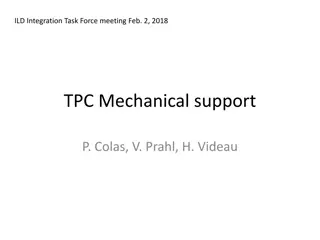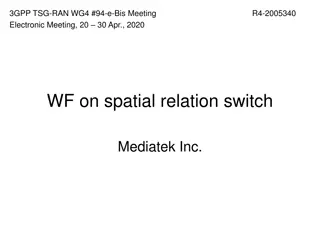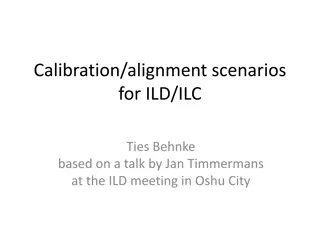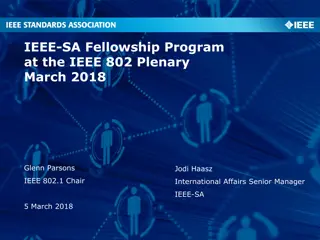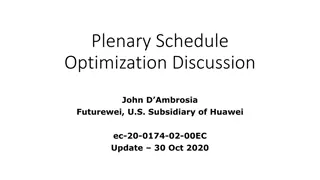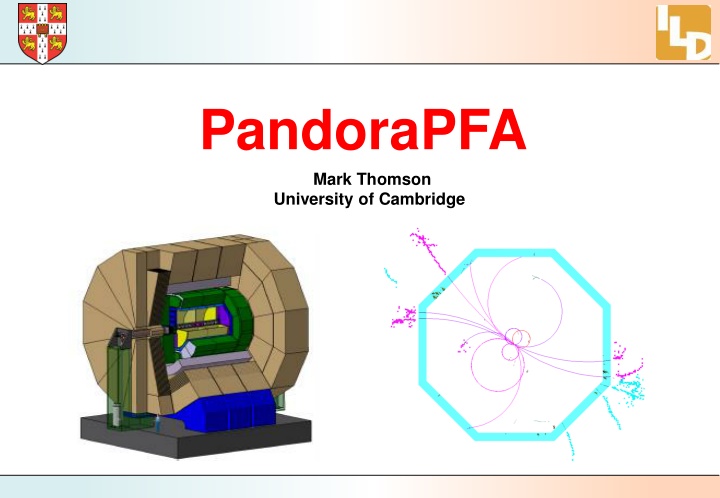
Innovations in PandoraPFA Technology at University of Cambridge
Explore the advancements in PandoraPFA technology by Mark Thomson at University of Cambridge, showcasing improved software performance, better particle ID treatment, powerful event clustering, and more. Witness the evolution from CLIC_ILD to ILD_O1 with this cutting-edge framework.
Download Presentation

Please find below an Image/Link to download the presentation.
The content on the website is provided AS IS for your information and personal use only. It may not be sold, licensed, or shared on other websites without obtaining consent from the author. If you encounter any issues during the download, it is possible that the publisher has removed the file from their server.
You are allowed to download the files provided on this website for personal or commercial use, subject to the condition that they are used lawfully. All files are the property of their respective owners.
The content on the website is provided AS IS for your information and personal use only. It may not be sold, licensed, or shared on other websites without obtaining consent from the author.
E N D
Presentation Transcript
PandoraPFA Mark Thomson University of Cambridge
PandoraPFA New Since the LoI: Complete rewrite of PandoraPFA Old code obsolete - unsupported Advantages of PandoraPFANew: By design, initial version had (almost) identical performance Some subsequent improvements From a software perspective Code is well designed and sensibly structured Better software performance faster smaller memory footprint Well tested Extensively debugged for CLIC CDR But used CLIC_ILD (modified version of ILD00) 2 Fukuoka, May 2012 Mark Thomson
From a physics perspective, a number of advantages Somewhat better resolution, particular at higher energies CLIC_ILD EJET RMS90/EJ 45 GeV 100 GeV 180 GeV 250 GeV 3.6 % 3.1 % 3.0 % 3.3 % ILD RMS90/EJ EJET 45 GeV 100 GeV 250 GeV 500 GeV 1 TeV 1.5 TeV 3.6 % 2.9 % 2.8 % 3.0 % 3.2 % 3.2 % 3 Fukuoka, May 2012 Mark Thomson
Much better treatment of particle ID Muons Electrons Efficiency 0.95 Efficiency 0.9 0.75 0.85 0.8 0.9 0.7 0.8 1 1 0 0 20 100 40 200 Energy [GeV] 60 300 CLIC_ILD CLIC_ILD 80 [ q 400 ] o 4 Fukuoka, May 2012 Mark Thomson
Now a powerful clustering and particle flow framework which can cope with complex events CLIC_ILD e.g. a 3 TeV event at CLIC with 1.2 TeV of pile-up overlaid 5 Fukuoka, May 2012 Mark Thomson
Reconstructed PFOs clean enough to use cluster times to reject background tCluster 6 Fukuoka, May 2012 Mark Thomson
From CLIC_ILD to ILD_O1 7 Fukuoka, May 2012 Mark Thomson
PandoraPFA and ILD_O1 Recent IlcSoft changes should have no direct impact on PandoraPFA However a number of potential indirect impacts Run-time registered algorithms/tools and object book-keeping Isolate specific detector and software details, creating self- describing hits, tracks, etc. Pandora Client Application Pandora Framework Algorithm Manager CaloHit Manager Cluster Manager, etc. API ILD/Marlin 8 Fukuoka, May 2012 Mark Thomson
MarlinPandora - Pandora MarlinPandora: Providing calibrated energies for each calorimeter cell, Quality cuts for all tracks and calorimeter cells, Specifying information about inner-detector tracks and their relationships (kinks, prongs, split tracks) Changes in PandoraPFA performance can result from Calibration New tracking software New features Non-optimal quality cuts Current lack of track and relationships (kinks, prongs, ) Mokka related New features in modified/new drivers Dead material (i.e. one thing we would like to know) 9 Fukuoka, May 2012 Mark Thomson
1) Calibration Two aspects: Calibration of raw calorimeter energies ADC to GeV Correction to raw energy used internally by PandoraPFA if all is well this is a small correction accounts for effects such as not all hits being used in PFOs 10 Fukuoka, May 2012 Mark Thomson
ECAL Calibration ECAL calibration rather straightforward. Change CalibrECAL from 40.91, 81.81 to 42.91, 85.82 Pandora constants: ECAL_To_EM_GeV=1.00 HCAL_To_EM_GeV=1.00 11 Fukuoka, May 2012 Mark Thomson
HCAL Calibration HCAL calibration more difficult: KL energy divided between ECAL/HCAL Optimise for jet energy reconstruction CalibrHCAL from 34.80 to 58.60 Pandora constants: ECAL_To_HAD_GeV = 1.05 HCAL_To_HAD_GeV = 1.00 12 Fukuoka, May 2012 Fukuoka, May 2012 Mark Thomson Mark Thomson
Calibration looks fine 13 Fukuoka, May 2012 Mark Thomson
Now Look at Z Assess PFA performance using Zs at different energies decaying at rest into light quarks two back-to-back jets Use IlcSoft v01-13-05 version of Mokka to process same stdhep files for both ILD_00 and ILD_O1_v02 Same physics lists, etc. In simulation change only detector model Reconstruct events with IlcSoft v01-13-05: i) using old tracking/calibration with ILD00 (previously validated steering file) ii) new tracking/calibration with ILD_O1 (new steering file from ILDConfig repository NOTE: technically not possible to run new tracking with ILD00 or old tracking with ILD_O1 uds 14 Fukuoka, May 2012 Mark Thomson
Different simulation of same generated events no direct event-by-event comparison is possible Event 1 Same 91GeV Z uds stdhep file Same physics list and Mokka version IlcSoft v01-13-05 Same PandoraPFA ILD_00 Old ILD_O1_v02 New Tracking/Calibratio n Tracking/Calibrati on Can only make statistical comparisons 15 Fukuoka, May 2012 Mark Thomson
2) Tracking Changes New track reco: track quality cuts in MarlinPandora may not be appropriate: For first tests, simply apply old cuts KinkFinder and V0Finder processors, do not yet work with new tracks Kinks and V0s not used (should be a relatively small effect) First compare numbers of good tracks Good tracks All tracks 16 Fukuoka, May 2012 Mark Thomson
Tracking Changes MarlinPandora also specifies a number of track properties which tell the algorithms how to use the tracks: CanFormPfo flag CanFormClusterlessPfo flag clusterlessPFO flag Good tracks canFormPFO = false 17 Fukuoka, May 2012 Mark Thomson
Z uds Results Degradation in jet energy resolution especially at EZ=91GeV RMS90(Ej)/<Ej> ILD_00 ILD_O1_v02 91GeV 3.69 0.05 % 4.15 0.05 % 500GeV 3.40 0.05 % 3.48 0.05 % 12 % @ 91 GeV 2 % @ 500 GeV 18 Fukuoka, May 2012 Mark Thomson
No obvious angular dependence of effect at 91 GeV Some structure at 500 GeV ILD_O1 better in endcap Degradation near theta cos = 0 19 Fukuoka, May 2012 Mark Thomson
Suspicious Minds For low jet energies calorimeter resolution is largest contribution to jet energy resolution low energy tracks is important For higher jet energies confusion dominates everything Finger of suspicion points at: interface between new tracking and Pandora worse HCAL resolution can account for some of the effect 20 Fukuoka, May 2012 Mark Thomson
Summary There are issues with PFA reconstruction of ILD_O1 Origin is uncertain suspicion it is related to low energy tracks possible some impact of HCAL resolution but could be related to new drivers or related to the inclusion of material The problem The ideal way forward Break down problem one aspect at a time e.g. run old and new tracking on ILD_O1 could compare reconstructed tracks but this is not possible Many changes PandoraPFA New tracking New drivers Dead material Hard to identify statistically 21 Fukuoka, May 2012 Mark Thomson
Conclusions There are issues with PFA reconstruction of ILD_O1 Origin is uncertain don t have a good quick way of identify source Options Live with degraded performance, but could indicate a more serious problem lose any handle on understanding impact of material a significant step backwards from LoI Fix it but not trivial and will take weeks not days need stable software underneath any new MC studies require large event samples need to coordinate tracking/PFA 22 Fukuoka, May 2012 Mark Thomson




